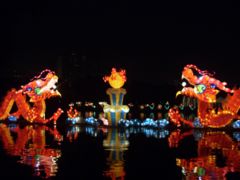| Mid-Autumn Festival | |
|---|---|
 Festival decorations in Beijing | |
| Also called | Moon Festival, Mooncake Festival |
| Observed by | Chinese people |
| Type | Cultural, religious |
| Significance | To commemorate and celebrate the end of the autumn harvest |
| Celebrations | Lantern lighting, mooncake making and sharing, courtship and matchmaking, fireworks, family gathering, dragon dances, family meal, visiting friends and relatives, gift giving |
| Observances | Consumption of mooncakes and cassia wine |
| Date | 15th day of the 8th month of the Chinese lunar calendar |
| 2023 date | 29 September |
| 2024 date | 17 September |
| 2025 date | 6 October |
| Frequency | Annual |
| Related to | Chuseok (Korea), Tsukimi (Japan), Tết Trung Thu (Vietnam), Uposatha of Ashvini or Krittika (Cambodia, Laos, Myanmar, Sri Lanka, and Thailand) |
The Mid-Autumn Festival (for other names, see § Etymology) is a harvest festival celebrated in Chinese culture. It is held on the 15th day of the 8th month of the Chinese lunisolar calendar with a full moon at night, corresponding to mid-September to early October of the Gregorian calendar.[1] On this day, the Chinese believe that the moon is at its brightest and fullest size, coinciding with harvest time in the middle of autumn.[2]
The Mid-Autumn Festival is one of the most important holidays in Chinese culture; its popularity is on par with that of Chinese New Year. The history of the festival dates back over 3,000 years.[3][4] Similar festivals are celebrated by other cultures in East and Southeast Asia.
During the festival, lanterns of all size and shapes – which symbolize beacons that light people's path to prosperity and good fortune – are carried and displayed. Mooncakes, a rich pastry typically filled with sweet-bean, egg yolk, meat or lotus-seed paste, are traditionally eaten during this festival.[5][6][7] The Mid-Autumn Festival is based on the legend of Chang'e, the Moon goddess in Chinese mythology.
- ^ Yang, Fang (12 September 2011). "Mid-Autumn Festival and its traditions". Archived from the original on 13 April 2012.
The festival, celebrated on the 15th day of the eighth month of the Chinese calendar, has no fixed date on the Western calendar, but the day always coincides with a full moon.
- ^ Pinky Chng; William Tan (19 September 2020). "Mooncakes, lanterns and legends: Your guide to the Mid-Autumn Festival in Singapore". AsiaOne. Retrieved 16 October 2024.
- ^ "Moon Festival – The Chinese Mid Autumn Festival". 3 June 2021.
- ^ Roy, Christian (2005). Traditional Festivals: A Multicultural Encyclopedia, Volume 1. ABC-CLIO. pp. 282–286. ISBN 978-1576070895.
- ^ "Mid-Autumn Festival in Other Asian Countries". www.travelchinaguide.com.
- ^ "A Chinese Symbol of Reunion: Moon Cakes – China culture". kaleidoscope.cultural-china.com. Archived from the original on 5 May 2017. Retrieved 4 October 2017.
- ^ "Back to Basics: Baked Traditional Moon Cakes". Guai Shu Shu. 10 August 2014. Retrieved 4 October 2017.